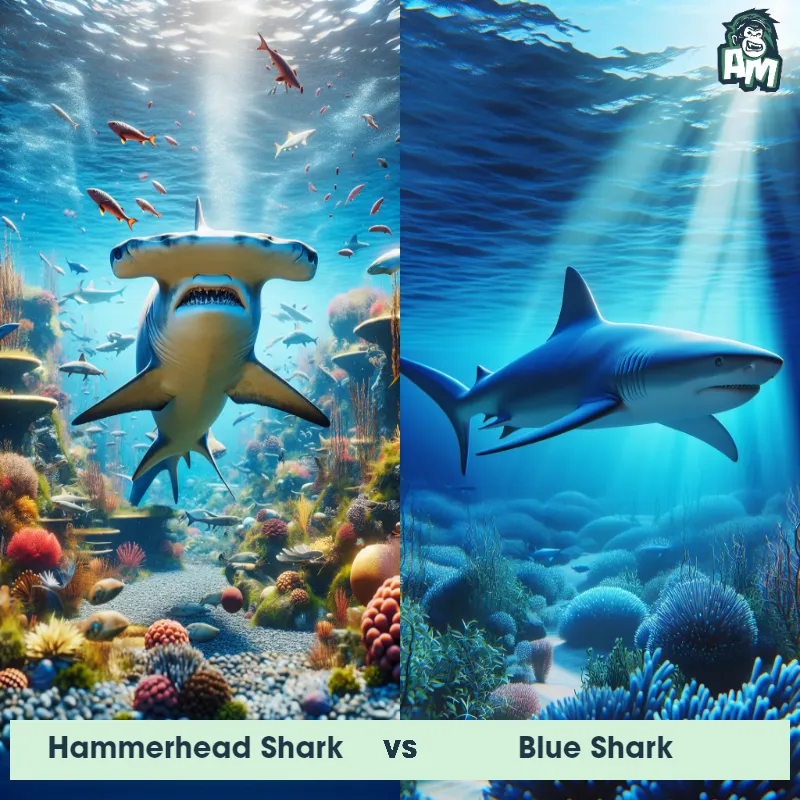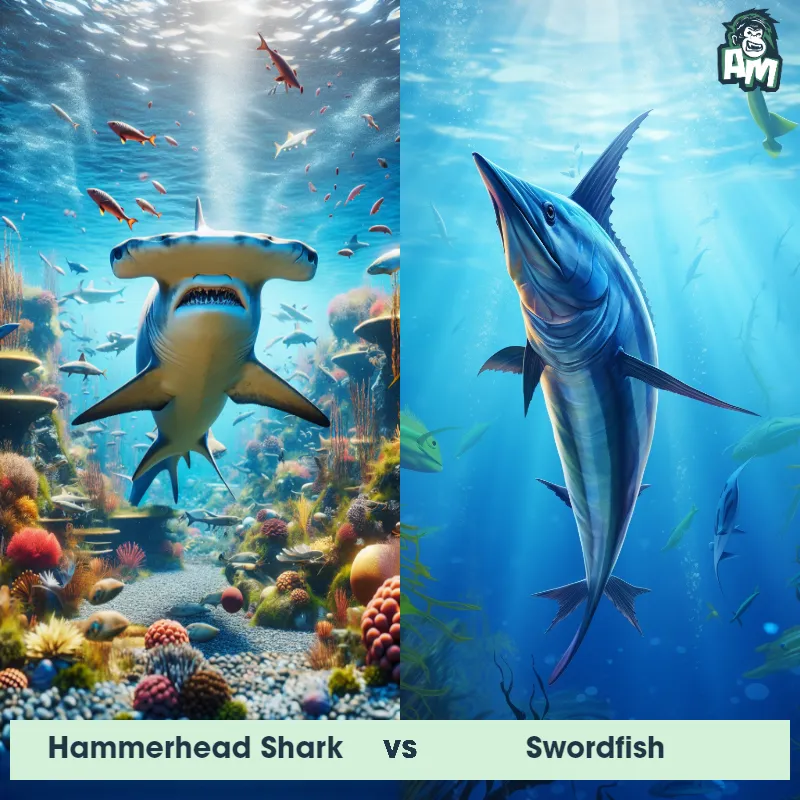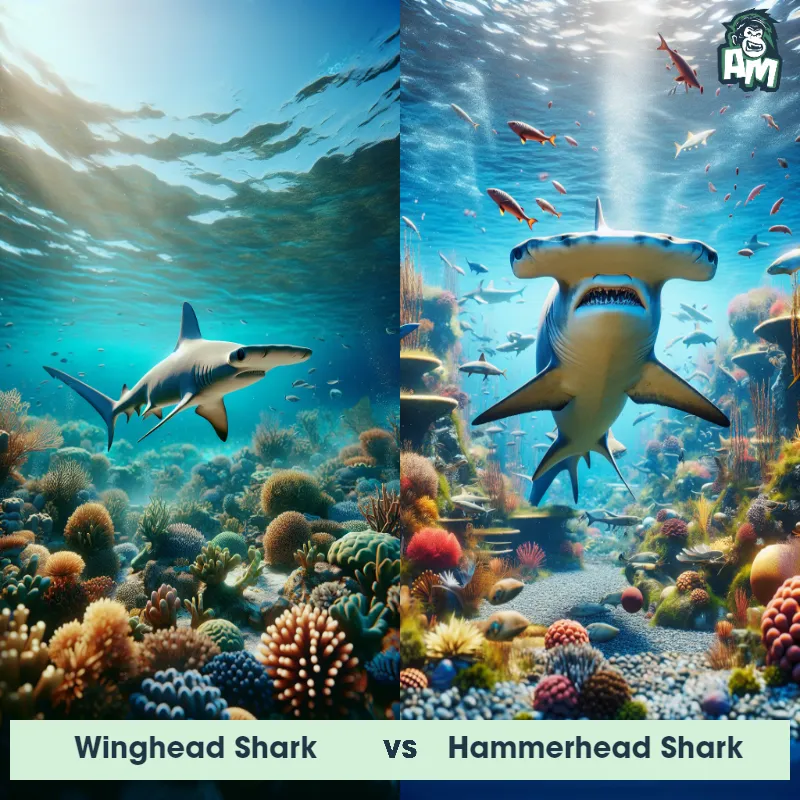The Hammerhead Shark
The Hammerhead Shark, scientifically known as Sphyrnidae, is a unique and fascinating marine creature. With its unmistakable appearance, the hammerhead shark stands out from other sharks due to its flattened head that resembles the shape of a hammer. This distinctive cranial structure, known as the cephalofoil, allows the shark to have enhanced sensory perception and a wider field of vision. The hammerhead shark is predominantly grey or brown in color, with a slender body and a length that can range from 10 to 20 feet. It is an exceptional swimmer, capable of swift movements and impressive agility in the water. Its diet primarily consists of fish, squid, and stingrays, and it is known to migrate long distances during specific times of the year. As a solitary predator, the hammerhead shark can be found in tropical and warm temperate waters worldwide, making it a captivating creature to study and observe.

| Hammerhead Shark | |
|---|---|
| Size | Up to 20 feet (6.1 meters) |
| Weight | Up to 1,000 pounds (453.6 kilograms) |
| Speed | Speed: 25 mph (40 km/hr) |
| Key Strength | Powerful bite and strong swimming ability |
| Biggest Weakness | Vulnerable to attacks on the sides of its body |
| Scientific Name | Sphyrnidae |
| Family | Sphyrna |
| Habitat | Saltwater |
| Geography | Warm waters around the world |
| Diet | Stingrays, fish, squid, octopus, crustaceans |
| Lifespan | 20 years - 30 years |

The Hammerhead Shark
The Hammerhead Shark, scientifically known as Sphyrnidae, is a unique and fascinating marine creature. With its unmistakable appearance, the hammerhead shark stands out from other sharks due to its flattened head that resembles the shape of a hammer. This distinctive cranial structure, known as the cephalofoil, allows the shark to have enhanced sensory perception and a wider field of vision. The hammerhead shark is predominantly grey or brown in color, with a slender body and a length that can range from 10 to 20 feet. It is an exceptional swimmer, capable of swift movements and impressive agility in the water. Its diet primarily consists of fish, squid, and stingrays, and it is known to migrate long distances during specific times of the year. As a solitary predator, the hammerhead shark can be found in tropical and warm temperate waters worldwide, making it a captivating creature to study and observe.
Fun Fact: The Hammerhead Shark possesses a remarkable sense of smell, capable of detecting a drop of blood from a distance as far as a mile away, making it an immensely efficient hunter.
| Hammerhead Shark | |
|---|---|
| Size | Up to 20 feet (6.1 meters) |
| Weight | Up to 1,000 pounds (453.6 kilograms) |
| Speed | Speed: 25 mph (40 km/hr) |
| Key Strength | Powerful bite and strong swimming ability |
| Biggest Weakness | Vulnerable to attacks on the sides of its body |
| Scientific Name | Sphyrnidae |
| Family | Sphyrna |
| Habitat | Saltwater |
| Geography | Warm waters around the world |
| Diet | Stingrays, fish, squid, octopus, crustaceans |
| Lifespan | 20 years - 30 years |
Hammerhead Shark Matchups
We use AI to simulate matchups between the Hammerhead Shark and other animals. Our simulation considers size, strength, and natural predatory behaviors to determine the most likely outcome.

Can't find the Matchup you want?
Create Your Own MatchupHammerhead Shark: Diet, Predators, Aggression, and Defensive Behaviors
What do Hammerhead Sharks eat?
Hammerhead Sharks primarily feed on a diet of fish, including smaller species such as sardines, herring, and mackerel. They also consume a variety of other marine creatures like squid, octopus, and crustaceans. Their unique head shape allows them to have a wider field of vision, making it easier for them to detect and catch their prey.
Do Hammerhead Sharks have any predators?
While adult Hammerhead Sharks do not have many natural predators due to their size and strength, younger individuals are vulnerable to larger sharks such as tiger sharks, great white sharks, and bull sharks. Orcas, also known as killer whales, have been observed preying on Hammerhead Sharks as well.
Are Hammerhead Sharks aggressive?
Hammerhead Sharks are generally not considered aggressive towards humans unless provoked or threatened. They are known to be more curious than aggressive and often swim away from humans when encountered. However, it is important to exercise caution when swimming or diving in waters where Hammerhead Sharks are present.
Do Hammerhead Sharks engage in fights?
Hammerhead Sharks are known to engage in aggressive behaviors towards other sharks, especially during feeding frenzies or territorial disputes. They may use their sharp teeth and powerful jaws to assert dominance and establish their territory. Physical fights among Hammerhead Sharks are not uncommon during mating season or when food sources are limited.
How do Hammerhead Sharks defend themselves?
One of the main ways Hammerhead Sharks defend themselves is by traveling in large schools or groups, which provides them with safety in numbers against potential predators. Their high agility and speed also help them evade attackers. Additionally, their unique head shape may serve as a defensive mechanism by allowing them to maneuver effectively and resist predators during an attack.
What is the biggest weakness of Hammerhead Sharks in a fight?
Despite their strength and hunting capabilities, the biggest weakness of Hammerhead Sharks in a fight is their vulnerability to larger predators or groups of aggressive sharks. Their size and solitary nature can put them at a disadvantage when facing a formidable opponent. In such situations, they may rely on their agility and speed to escape or evade the threat.
Fun Fact: Hammerhead Sharks exhibit a unique hunting strategy called "cephalofoil panning." By sweeping their exceptionally wide head from side to side, they can detect and locate prey more precisely, even if it is hiding under the sand or camouflaged in the surrounding habitat.
Fun Fact: Hammerhead Sharks are excellent navigators, believed to possess an exceptional homing ability. Studies have shown that some individuals undertake long-distance migrations, traveling thousands of miles and returning to the exact location where they were born to give birth to their own offspring.























